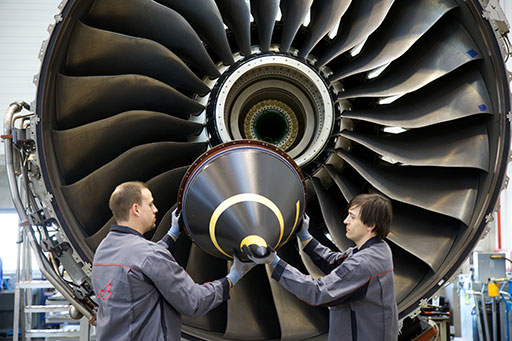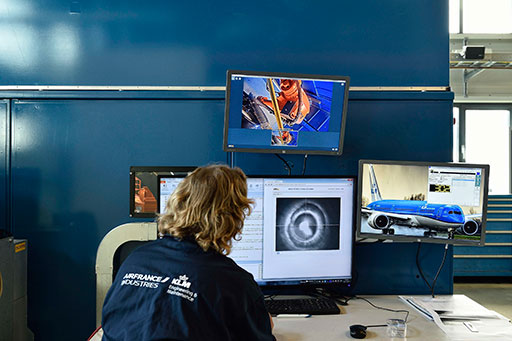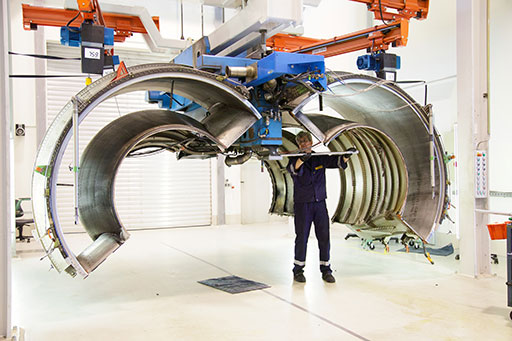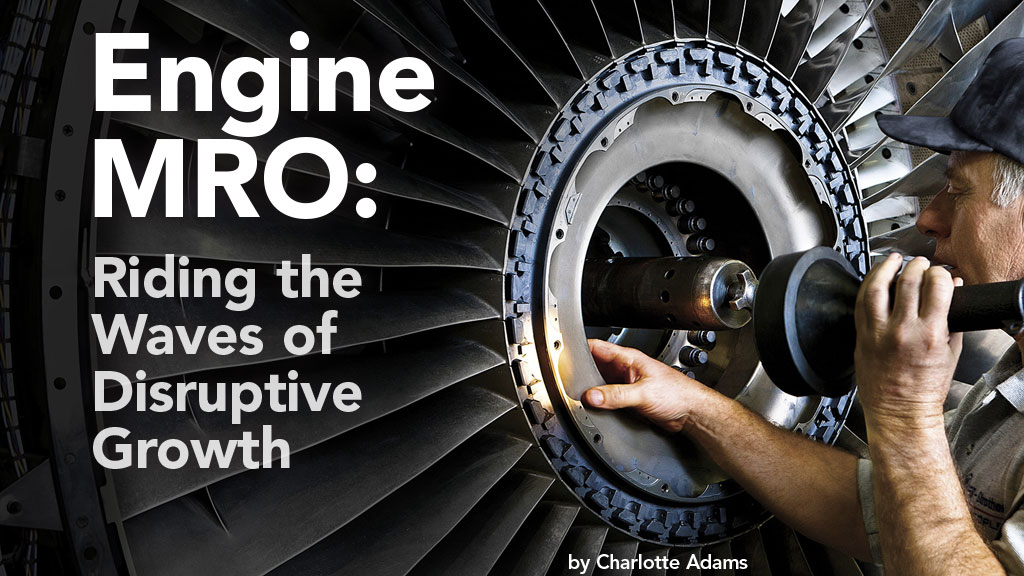As commercial passenger traffic hits new records and world fleets expand, the engine MRO market is primed for growth. But tectonic shifts in regional market shares, the expanding OEM footprint, and the onrush of new technologies will require flexibility, adaptability, and laser-like focus on customer needs to compete in this disruptive environment.

Fleet growth means newer, more fuel-efficient engines with longer time on wing. And new engines are closely tethered to the OEMs in the early years, and often for longer periods, through OEM service agreements reached at the point of sale.
According to Oliver Wyman’s Global Fleet & MRO Market Forecast for 2017-2027, the world fleet will grow from about 25,000 to about 35,000 airplanes during this period, driven by Asia, especially China and India.
Oliver Wyman further estimates that engine MRO will grow from $29.6 billion to $47.9 billion during the forecast period — 4.9 percent compound annual growth rate (CAGR). The A320CEO/NEO and the 737NG/MAX will continue to be top overall MRO breadwinners, followed at various distances by the 777, 787, A330CEO/NEO, and A350.
MTU Maintenance expects global MRO revenues to grow faster than 5 percent – increasing by up to 8 or 9 percent, driven by inflation, says Leo Koppers, senior vice president for MRO programs with the aftermarket division of MTU Aero Engines. At the same time he estimates that shop visits will increase by only about 3 percent per year over the next 10 years, from around 8,000 today to nearly 11,000.
Engine MRO’s share of the total MRO market – “including APUs and Props” — is set to grow to almost half of commercial aviation MRO by 2022, reflecting rising material prices, says Marc Wilken, senior director of engine product sales and lease at Lufthansa Technik (LHT). (He cites the 2017 ICF MRO forecast.) The main revenue drivers in the engine MRO business are narrow-body engines, such as the V2500 and the CFM56-5B and -7B.
Near the top of the food chain, GE Aviation has a services backlog of $121 billion, says Bill Dwyer, GE Aviation Services marketing leader. GE and its joint ventures, CFM International and Engine Alliance, have more than 36,000 engines in commercial service, more than 60 percent of which have yet to have their first shop visit, he says. More than 22,000 CFM56-5B and -7B engines have been delivered to about 570 operators, approximately 62 percent of which have yet to have their first shop visit.
Last year GE’s and its JVs’ fleets registered 4,500 shop visits, a number expected to rise to 5,600 by 2020, Dwyer says. This is the total “for all shops,” including GE and its competitors. GE has “an open network approach to MRO,” he says, which allows room for third-party overhauls and repairs. But the company also sees “a growing demand for long-term service agreements on our newer engines like the GEnx.”
Macro Trends
LHT sees two parallel trends. On the one hand, established narrow-body engine types – such as the V2500 and the CFM56-5B/-7B – are still growing, Wilken says. He expects this fleet to peak in 2018, generating MRO demand for a number of years.
At the same time, however, new engine types are entering the market, requiring different skills and flexible solutions. “LHT is already prepared to cope with these circumstances.”
LHT is very flexible – “able to offer any price or contract model requested by the customer, be it single-event, long-term fleet management programs, PBH offerings, or similar [programs],” Wilken says. “We will adapt to whatever requirement our customers have in regard to price model, cash-flow, risk transfer, … lease return conditions, etc.”

Lufthansa Technik sees its core competency “in optimizing MRO cost to the benefit of our customers by offering non-standard, highly customized solutions based on the foundation of our worldwide production network.” He cites LHT’s smart.life offering, built on the MRO’s experience with work-scoping, repairs, digital modeling, and operations.
Used serviceable material (USM) likewise is becoming a key factor in competitiveness. Being able to offer high-quality, well documented USM, especially LLPs with remaining life, “determines the costs of engine overhauls and therefore the attractiveness of an MRO’s offering,” Wilken says. And if an MRO can offer “some sort of commitment [such as] guaranteeing a certain USM ratio,” the MRO is better positioned, as it reduces an airline customer’s “availability risk.” “USM is very popular for engines such as CFM56-5B/-7B and V2500, particularly regarding fast-moving parts such as LLPs,” Koppers adds.
MTU Maintenance expects the most growth in the coming decade in the PW1000G family and the GE90 “Growth” variant, “especially as these engines age and migrate from first- to second-tier operators,” Koppers says. “In absolute numbers our focus also will be on the V2500, CFM56-5B/-7, and the CF34-8/-10 engine families.” Parent, MTU Aero Engines and LHT are planning a 50/50 JV for MRO of geared turbofan engines.
MTU is focusing on using big data to better plan shop visits, parts logistics, and manage fleets. (MTU image)
OEM Defense
There will be increased OEM coverage for next-generation engines, Koppers says, so players, especially independents, “will need to intensify their cooperation with OEMs in order to access both engine MRO and potentially IP-protected repair licenses, as well as MRO volume.”
MTU Maintenance is prepared to navigate the changing environment, Koppers says. It boasts the world’s largest engine maintenance portfolio — more than 30 engines – and more than 150 airline customers, he says. With a 10 percent share of the engine MRO market, the unit has developed “highly customized and integrated solutions across the engine lifecycle.”
MTU Aero Engines’ commercial maintenance business – including MTU Maintenance and some replacement parts activities via the OEM business – registered 32 percent growth in the first six months of 2017, shooting from 893.3 million euros to 1,181.0 million euros.
And it doesn’t hurt that MTU Aero Engines is a risk and revenue sharing partner with OEMs, enjoying access to the aftermarket networks for the PW1100G-JM, GEnx, GP7200, and (in future) the GE9X.
Air France Industries KLM Engineering & Maintenance also anticipates a lot of change, as airlines shift toward new-generation airplanes such as the 787, A350, 737MAX, and A320NEO and their associated engines. As new-generation engines increase in numbers, OEMs will increase their grip on quality in the aftermarket via licensing systems to perform maintenance, says Vincent Metz, head of strategy for AFI KLM E&M.
But the Franco-Dutch MRO is prepared to deal with the changing landscape. For example, it has formed a 49/51 joint venture with Safran Aircraft Engines on engine part repair, dubbed Airfoils Advanced Solutions. Slated to begin operations next year, the JV will focus on high-pressure compressor blades and variable stator vanes for CFM56, GE90, and GP7200.
LHT, meanwhile, is partnering with GE Aviation on the XEOS JV, which will overhaul GEnx-2B and GE9X engines. XEOS is slated to open its facility in Poland in 2019. LHT also has a JV with Rolls-Royce, N3 Engine Overhaul Services, for maintenance and repair of Trent engines and components.

TrueChoice
GE Aviation touts last year’s launch of TrueChoice, a suite of offerings that “spans the entire lifecycle,” Dwyer says, featuring everything from long-term agreements, material agreements, time-and-material overhauls, to custom pacts.
So far GE has rung up more than $1 billion in TrueChoice agreements. The program had enrolled 15,000 engines by March 2017, involving more than 200 operators and lessors.
No slacker, CFM this year has announced almost $4.4 billion-worth of “rate per flight hour” (RPFH) LEAP support pacts with Arkia ($200 million), China Eastern, ($2.185 billion), and Turkish Airlines (THY) ($2 billion). CFM also describes its approach to overhaul as open. “There are about 40 third-party MRO shops licensed to work on CFM56 engines,” Dwyer says. To that point AFI KLM E&M recently announced LEAP support including both on wing/on-site support and shop visits. So far about 14,000 LEAPs have been ordered, about half of which are covered by CFM maintenance agreements, most of them, RPFHs.
Technology Investments
Developing new tools is essential in keeping up with the technology curve. AFI KLM E&M’s MRO Lab, for example, has produced tools such as PROGNOS for Engines, software for statistical analyses of engine data to enable dynamic monitoring and predictive maintenance.
MTU Maintenance also emphasizes data analytics. “Big data will take … condition analytics into the predictive sphere,” Koppers says. This means not only that “negative trends can be caught early and rectified – as is the case today – but [also that] MRO providers will be able to analyze larger patterns, better predict performance in the field and, as a result, better plan shop visits, parts logistics, and manage fleets.” These factors will result in parts savings and shorter turn times, he says. MTU Maintenance is “optimizing our engine trending monitoring program with these key goals in mind.”
GE Aviation is pursuing increased automation. This summer it acquired the British firm, OC Robotics, which Dwyer describes as “the world’s leading designer and manufacturer of commercial snake-arm robots and software for confined and hazardous environments.” He expects the move will expand component repair development capabilities and increase the efficiency of on-wing inspections and repairs.
Chinese To Go
The Chinese engine MRO market for commercial jets will have a CAGR of 11.2 percent in constant U.S. dollars from 2017-2027, Koppers says, citing CAVOK’s 2017 engine MRO forecast. Further, there will be an increase in shop visits from about 700 today to more than 2,200 in 2027.
As most of these visits will involve narrow-body engines, MTU Maintenance Zhuhai – a joint venture with China Southern, the country’s largest airline group — is ideally placed to serve this growth, he says. The JV’s revenues have doubled in the last five years.
Ameco Beijing, the 25/75 joint venture between LHT and Air China, meanwhile, is the biggest aircraft technical support services provider in China, according to the German giant. Among other things, it overhauls Rolls-Royce, Pratt & Whitney, CFM, and IAE engines.
This year GE Aviation opened a Repair Technology Development Center in Shanghai. As of March 2017, the engine maker reported nearly 5,000 GE and CFM engines in operation in “Greater China.”
Other countries in Asia and the Pacific Rim also have drawn investment from Western MROs. Airfoil Services Sdn. Bhd. (ASSB), a 50/50 joint venture between MTU Aero Engines and LHT, based in Kuala Lumpur, Malaysia, has multiplied revenues nine-fold since 2003.
This year GE Aviation and SIA Engineering Co. signed an agreement for a 51/49 engine overhaul JV based in Singapore. Subject to regulatory approvals, the new entity will provide a full range of engine services for the GE90 and GE9X.
Lessor Services
Lessors are becoming a major factor as engine ownership moves from operators to investors. Koppers cites a 2015 Boeing analysis which pegged the percentage of the commercial fleet under operating leases as going from less than 15 percent in 1990 to about 25 percent in 2000, and up to about 40 percent today. He expects it to approach 50 percent of all aircraft in the future.
The trend will be more pronounced with new engine types – and airframes – which will be majority-owned by lessors, LHT’s Wilken predicts. And lease contracts contain a lot of technical specifications and restrictions, he adds. LHT offers “entire MRO solutions to meet lessors’ requirements as well as lessees’ needs.”
It is important to take this shift into account, Koppers says, as “investors have different overall goals” — ensuring asset value retention and optimizing their exit strategy. Lessors, furthermore, increasingly want “to take a more active role … in managing their most valuable asset – engines.” They “want to be directly involved in engine maintenance decisions, particularly during the transition between lessees, in managing and optimizing maintenance reserves and choosing the timing of engine shop visits.”
MTU Maintenance offers cradle-to-grave services extending all the way “to maximizing value at the end of the engine’s service life, for instance, through a sale, extended lease-out, or teardown for serviceable material.” These services simplify transitions and mitigate financial and technical risk, benefitting lessors and lessees.
AAR: Engine LRU Specialist
Engine component MRO is a growth area for AAR, says Andre op’t Hof, director of commercial operations for AAR Component Repair. The company does not repair the engine, itself, but repairs and overhauls LRUs such as fuel and hydraulic pumps, air turbine starters, integrated drive generators (IDGs), valves, and sensors. AAR focuses on engine models such as the CFM56, PW2000, V2500, and GE34.
“It is an important segment of AAR’s component repair capabilities that perfectly complements our other strengths in starters, generators and IDGs, pneumatic components, fuel and hydraulic pumps, and actuation.”
AAR’s services range from cost-per-hour programs, to stand-alone exchanges, to trading – selling of used serviceable material – and component repair and overhaul.
